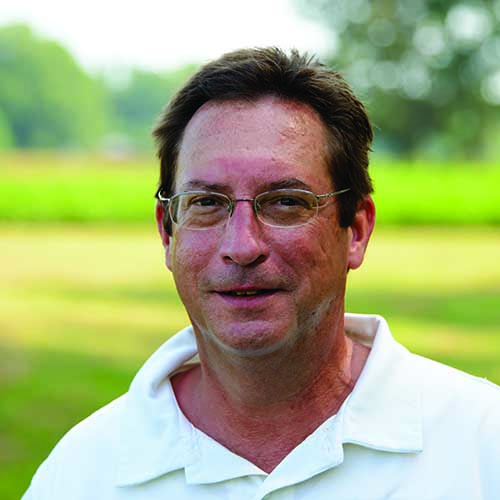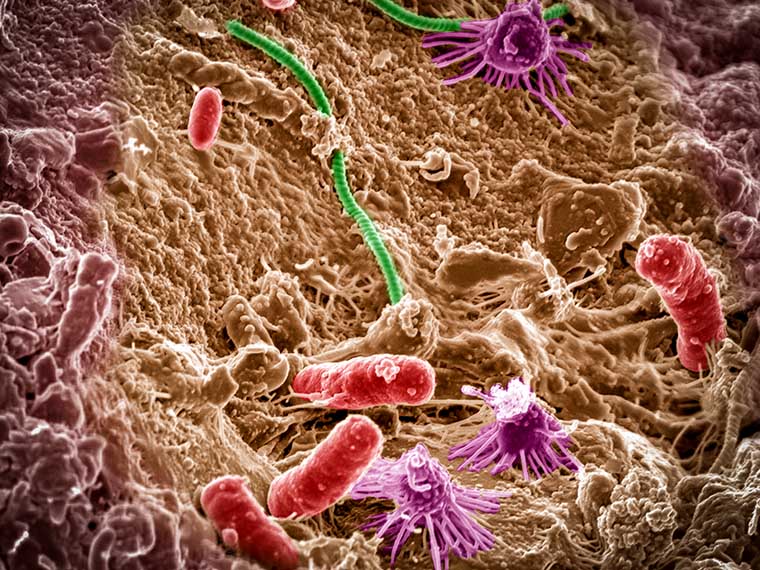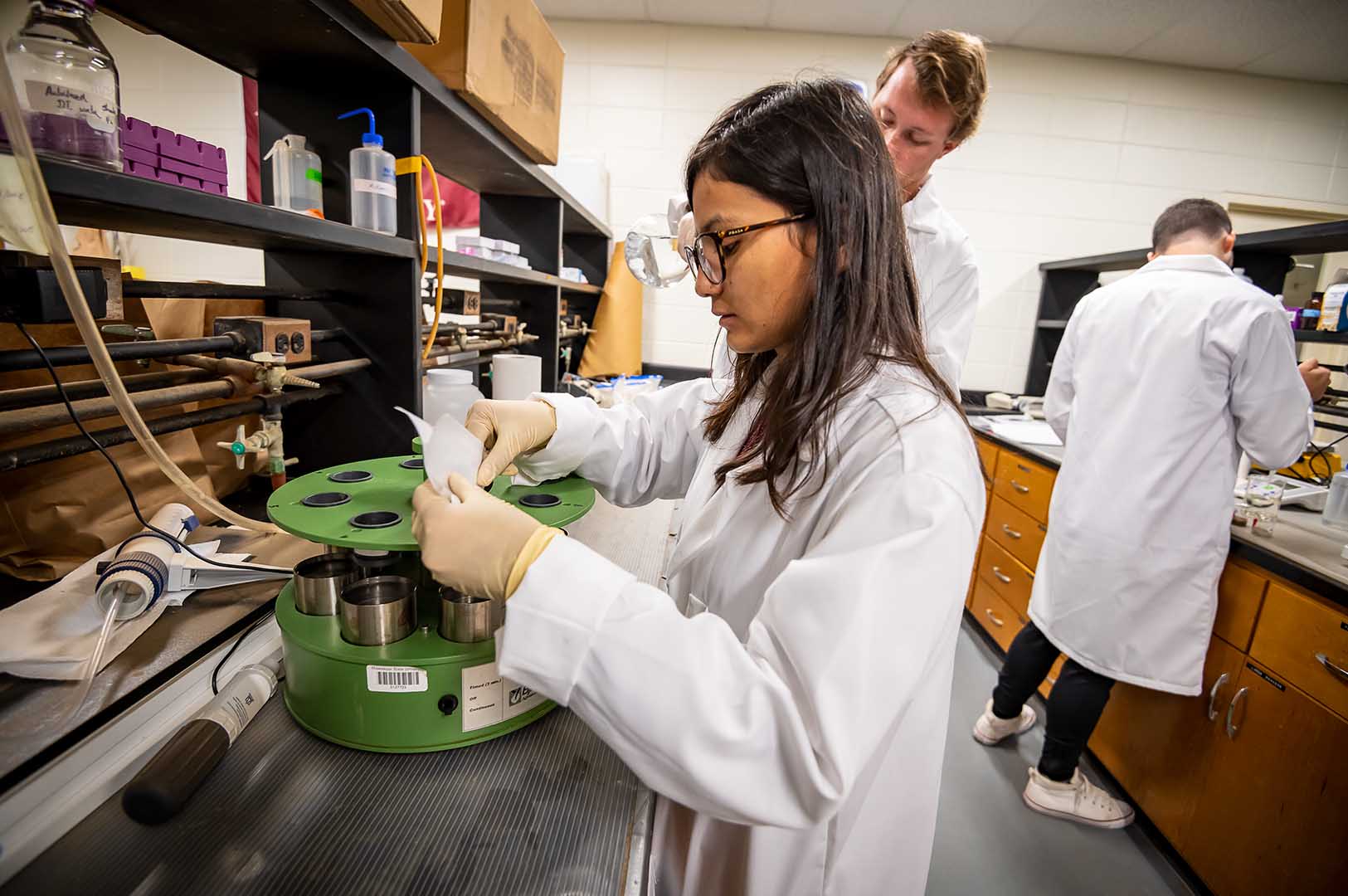The information presented on this page may be dated. It may refer to situations which have changed or people who are no longer affiliated with the university. It is archived as part of Mississippi State University's history.
On the surface, it may appear to be the richest, blackest soil, or it may be sandy, silty, or red clay. However, what lies beneath the surface of any soil is a living ecosystem with millions of bacteria and organisms working in concert to create the soil structure.
Cover crops provide a suite of soil benefits including increased organic matter, improved air and water movement, reduced compaction, and capture and recycling of nutrients. Clearly, cover crops are affecting soil structure but how do they contribute to soil health?
To determine what is going on beneath the surface when cover crops are added to a cash crop system, MAFES scientists Drs. Billy Kingery and Shankar Ganapathi Shanmugam, are assessing soil health in the plant and soil sciences' Soil Microbial Metagenomics Laboratory. Kingery is a professor in the Department of Plant and Soil Sciences, and Ganapathi Shanmugam is an assistant research professor in the Institute for Genomics, Biocomputing and Biotechnology.
The soil microbial ecologists are working with Dr. Mark Shankle, a MAFES agronomist in plant and soil sciences stationed at the Pontotoc Ridge-Flatwoods Branch Experiment Station. Their study is evaluating the effects of five different cover crops, three different fertilizer treatments, and two planting dates in dryland soybean. The study is focused on identifying production practices that will improve soil health while also providing for more consistent soybean yields in a dryland environment.
Cover crops in the study include cereal rye, vetch, wheat, native vegetation or natural winter weeds, and a Natural Resources Conservation Service (NRCS) recommended mix of mustard and cereal rye. The fertilizer treatments include no fertilizer, fertilizer based on soil testing laboratory results, and poultry litter. Early and late planting dates are also included in the study design.
The first-year results of the six-year study were less than optimal, due to poor weather conditions at harvest. However, the second year provided a more bountiful harvest and better data.
"In the second year, there was more plant biomass from cover crops in the late planted soybean date system, greater soybean yield from the early planting system, and greater soybean yield from plots fertilized with poultry litter," Shankle said.
Understanding soil health and related management decisions in a dryland soybean environment is a significant portion of the study. Scientists are also homing in on which cover crop provides the most benefit at the lowest cost.
"One of the reasons we chose winter wheat as a cover crop in this study is because growers seem to prefer wheat since it is easier to manage and provides good soil coverage," Shankle said. "Unlike other cover crops, there are many varieties of wheat available so growers can choose a cheaper variety and adjust the planting population to help with costs."
Cereal rye can produce more biomass than wheat and can physically act to suppress weeds in the spring, while hairy vetch has been shown to increase soil microbial biomass.
Typically, a legume cover crop such as vetch would not be considered as a companion for a soybean cash crop, but the researchers wanted to investigate for any potential benefits.
Finally, the NRCS mix of cereal rye and mustard is based on a decision tool the agency developed to assist farmers. Farmers answer 14 questions to determine which cover crop best suits their cropping and management needs.
"In our case, the NRCS decision tool suggested we plant a mixture of cereal rye and mustard. Mustard has a bio-fumigant effect that can act to suppress soil-borne pests and diseases, as well as some degree of naturally-occurring weed control," Shankle said. "Our goal is to determine the best cover crops for a dryland soybean system in Mississippi, along with other management requirements. You can plant an expensive cover crop or something that is not so expensive that might have the same benefit."
Back in the laboratory, Kingery and Ganapathi Shanmugam are definitive that cover crops are affecting the activities of the microbial communities; but determining how cover crops affect soil health as a component of farming systems is a broader, more difficult question to answer.
"Soil health can influence so many variables that its effects can be difficult to measure," Kingery said. "For example, if it is a wet year, an improvement in soil structure would provide for good drainage. Conversely, if it is a dry year, better soil structure would improve water retention. However, we can't simulate these conditions in a controlled field experiment since they are dependent on weather patterns."
Instead, the team is evaluating the microbial components associated with changes in soil structure and determining genetically-based indicators of nutrient availability and crop disease suppression.
"In the soil, we are trying to see who is there, meaning what bacteria and fungi are present in the soil, and what they are doing," Kingery said. "It's a systems approach. We have the cover crop and the cash crop as a system and are trying to figure out how to manage soil microbiomes to benefit the cash crop by way of the cover crop."
Using metagenomics analyses with microbial DNA, scientists have estimated the presence of about 20,000 species of bacteria out of nearly 200,000 of these single-celled organisms found in a single gram of soil. This diversity is added to the microscopic fungi also present. The next step is to determine what the microorganisms are doing.
"Microbes in the soil are living organisms that are constantly responding to changes in their environment. So, we know the microbial communities are changing with the presence of cover crops," Ganapathi Shanmugam said. "The soil is a buffet for bacteria. The addition of cover crops adds more items to the buffet, more things for microorganisms to feed on."
He went on to explain that microbes are scavenging for food and mineral resources.
"It could be that the substrates microbes need leads to processes that improve the availability of soil nutrients for the cash crop," Ganapathi Shanmugam said. "It could be that a mineral source they utilize is also required by a crop pathogen, so they are taking away resources from the pathogen, lessening disease pressure."
He explained that soil microorganisms perform many functions, and often they work in consortia or they may network which accomplishes soil health objectives.
"We extract the DNA from the entire community of microorganisms to determine who are the members of the soil microbiome and then we match their DNA sequences with genomic databases to determine what they are capable of doing," Ganapathi Shanmugam said.
At the end of the study, scientists plan to have recommendations on planting date, fertilizer type, and the ideal cover crops to plant in a dryland soybean production system to optimize yield potential and improve soil health.
"Dryland soybeans make up more than half of the soybean acres in Mississippi. Inconsistent yields are a problem for many dryland soybean producers due to the lack of rainfall at critical times during the growing season," Shankle said.
Evaluating different production practices and determining the most beneficial components that promote a more consistent crop yield while also improving and sustaining soil health would be a win-win for farmers and the environment, Shankle added.
This research is funded by the Mississippi Soybean Promotion Board.
The soil is a buffet for bacteria. The addition of cover crops adds more items to the buffet, more things for microorganisms to feed on.
Dr. Shankar Ganapathi Shanmugam
Behind the Science

Shankar Ganapathi Shanmugam
Assistant Research Professor
Education: B.S., Agricultural Sciences, Tamilnadu Agricultural University; M.S., Environmental Sciences, Dalhousie University; Ph.D., Agronomy, Mississippi State University
Years At MSU: 6
Focus: Applied and basic research on soil microbial ecology using metagenomics
Passion At Work: We use metagenomics and bioinformatics to understand how below-ground microbial community dynamics affect above-ground plant communities and how this interaction affects soil health.

Billy Kingery
Professor
Education: B.S., Agronomy-Soil Science; M.S., Agronomy, Louisiana State University; Ph.D., Agronomy, Auburn University
Years At MSU: 26
Focus: Agronomy-soil ecology
Passion At Work: To utilize metagenomics in farming systems research to answer scientific questions concerning the relation of soil microbial ecology to soil management and crop production.

Mark Shankle
Research Professor
Education: B.S., Agriculture Engineering Technology, B.S., Plant and Soil Science, M.S., Plant and Soil Science-Weed Science, University of Tennessee; Ph.D., Agronomy-Weed Science and Soils, Mississippi State University
Years At MSU: 19
Focus: Address critical needs and find solutions that maximize net-profit and promote environmental stewardship
Passion At Work: It is exciting for our research team to work with the agriculture industry along with other scientists and Extension specialists to help our growers produce a quality product that is highly competitive.


